
Fourth Quarter 2023 Earnings Conference Call Bill Rogers – Chairman & CEO Mike Maguire – CFO January 18, 2024
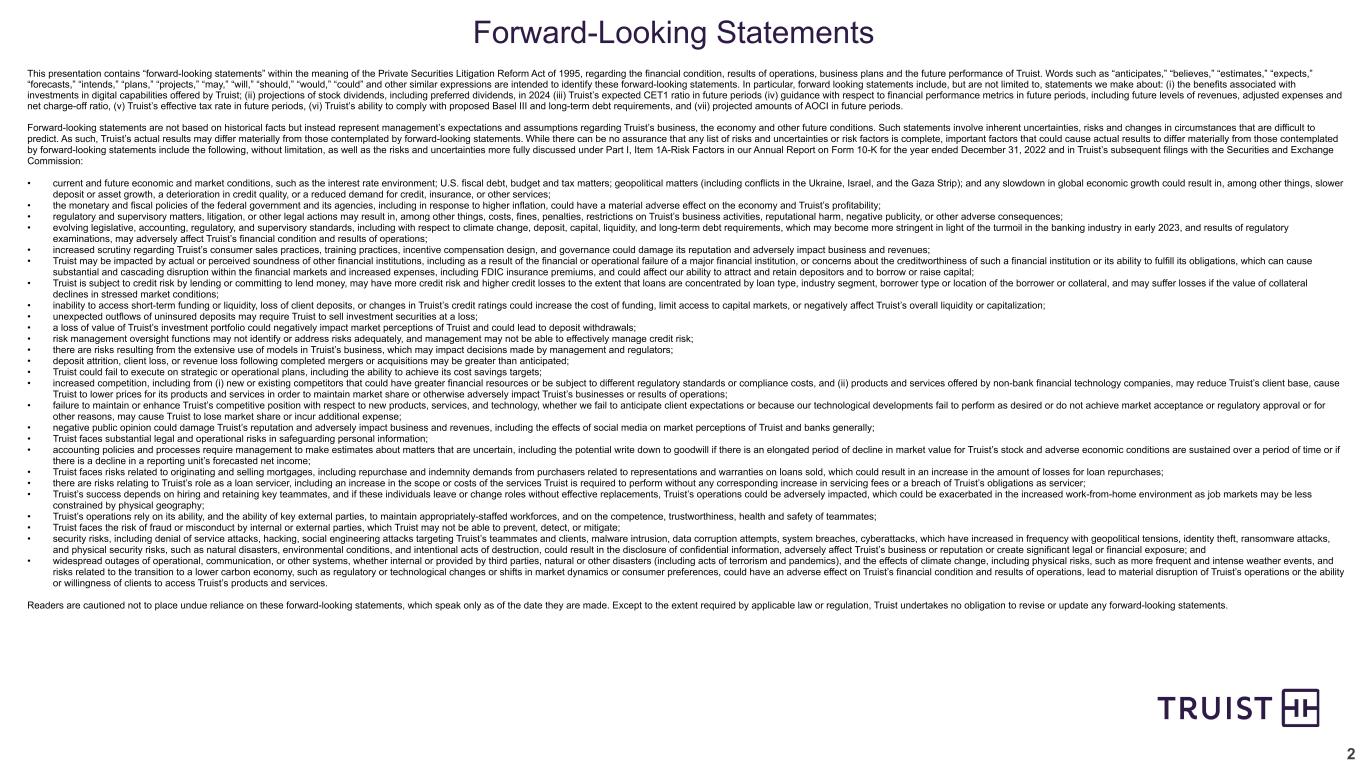
2 This presentation contains “forward-looking statements” within the meaning of the Private Securities Litigation Reform Act of 1995, regarding the financial condition, results of operations, business plans and the future performance of Truist. Words such as “anticipates,” “believes,” “estimates,” “expects,” “forecasts,” “intends,” “plans,” “projects,” “may,” “will,” “should,” “would,” “could” and other similar expressions are intended to identify these forward-looking statements. In particular, forward looking statements include, but are not limited to, statements we make about: (i) the benefits associated with investments in digital capabilities offered by Truist; (ii) projections of stock dividends, including preferred dividends, in 2024 (iii) Truist’s expected CET1 ratio in future periods (iv) guidance with respect to financial performance metrics in future periods, including future levels of revenues, adjusted expenses and net charge-off ratio, (v) Truist’s effective tax rate in future periods, (vi) Truist’s ability to comply with proposed Basel III and long-term debt requirements, and (vii) projected amounts of AOCI in future periods. Forward-looking statements are not based on historical facts but instead represent management’s expectations and assumptions regarding Truist’s business, the economy and other future conditions. Such statements involve inherent uncertainties, risks and changes in circumstances that are difficult to predict. As such, Truist’s actual results may differ materially from those contemplated by forward-looking statements. While there can be no assurance that any list of risks and uncertainties or risk factors is complete, important factors that could cause actual results to differ materially from those contemplated by forward-looking statements include the following, without limitation, as well as the risks and uncertainties more fully discussed under Part I, Item 1A-Risk Factors in our Annual Report on Form 10-K for the year ended December 31, 2022 and in Truist’s subsequent filings with the Securities and Exchange Commission: • current and future economic and market conditions, such as the interest rate environment; U.S. fiscal debt, budget and tax matters; geopolitical matters (including conflicts in the Ukraine, Israel, and the Gaza Strip); and any slowdown in global economic growth could result in, among other things, slower deposit or asset growth, a deterioration in credit quality, or a reduced demand for credit, insurance, or other services; • the monetary and fiscal policies of the federal government and its agencies, including in response to higher inflation, could have a material adverse effect on the economy and Truist’s profitability; • regulatory and supervisory matters, litigation, or other legal actions may result in, among other things, costs, fines, penalties, restrictions on Truist’s business activities, reputational harm, negative publicity, or other adverse consequences; • evolving legislative, accounting, regulatory, and supervisory standards, including with respect to climate change, deposit, capital, liquidity, and long-term debt requirements, which may become more stringent in light of the turmoil in the banking industry in early 2023, and results of regulatory examinations, may adversely affect Truist’s financial condition and results of operations; • increased scrutiny regarding Truist’s consumer sales practices, training practices, incentive compensation design, and governance could damage its reputation and adversely impact business and revenues; • Truist may be impacted by actual or perceived soundness of other financial institutions, including as a result of the financial or operational failure of a major financial institution, or concerns about the creditworthiness of such a financial institution or its ability to fulfill its obligations, which can cause substantial and cascading disruption within the financial markets and increased expenses, including FDIC insurance premiums, and could affect our ability to attract and retain depositors and to borrow or raise capital; • Truist is subject to credit risk by lending or committing to lend money, may have more credit risk and higher credit losses to the extent that loans are concentrated by loan type, industry segment, borrower type or location of the borrower or collateral, and may suffer losses if the value of collateral declines in stressed market conditions; • inability to access short-term funding or liquidity, loss of client deposits, or changes in Truist’s credit ratings could increase the cost of funding, limit access to capital markets, or negatively affect Truist’s overall liquidity or capitalization; • unexpected outflows of uninsured deposits may require Truist to sell investment securities at a loss; • a loss of value of Truist’s investment portfolio could negatively impact market perceptions of Truist and could lead to deposit withdrawals; • risk management oversight functions may not identify or address risks adequately, and management may not be able to effectively manage credit risk; • there are risks resulting from the extensive use of models in Truist’s business, which may impact decisions made by management and regulators; • deposit attrition, client loss, or revenue loss following completed mergers or acquisitions may be greater than anticipated; • Truist could fail to execute on strategic or operational plans, including the ability to achieve its cost savings targets; • increased competition, including from (i) new or existing competitors that could have greater financial resources or be subject to different regulatory standards or compliance costs, and (ii) products and services offered by non-bank financial technology companies, may reduce Truist’s client base, cause Truist to lower prices for its products and services in order to maintain market share or otherwise adversely impact Truist’s businesses or results of operations; • failure to maintain or enhance Truist’s competitive position with respect to new products, services, and technology, whether we fail to anticipate client expectations or because our technological developments fail to perform as desired or do not achieve market acceptance or regulatory approval or for other reasons, may cause Truist to lose market share or incur additional expense; • negative public opinion could damage Truist’s reputation and adversely impact business and revenues, including the effects of social media on market perceptions of Truist and banks generally; • Truist faces substantial legal and operational risks in safeguarding personal information; • accounting policies and processes require management to make estimates about matters that are uncertain, including the potential write down to goodwill if there is an elongated period of decline in market value for Truist’s stock and adverse economic conditions are sustained over a period of time or if there is a decline in a reporting unit’s forecasted net income; • Truist faces risks related to originating and selling mortgages, including repurchase and indemnity demands from purchasers related to representations and warranties on loans sold, which could result in an increase in the amount of losses for loan repurchases; • there are risks relating to Truist’s role as a loan servicer, including an increase in the scope or costs of the services Truist is required to perform without any corresponding increase in servicing fees or a breach of Truist’s obligations as servicer; • Truist’s success depends on hiring and retaining key teammates, and if these individuals leave or change roles without effective replacements, Truist’s operations could be adversely impacted, which could be exacerbated in the increased work-from-home environment as job markets may be less constrained by physical geography; • Truist’s operations rely on its ability, and the ability of key external parties, to maintain appropriately-staffed workforces, and on the competence, trustworthiness, health and safety of teammates; • Truist faces the risk of fraud or misconduct by internal or external parties, which Truist may not be able to prevent, detect, or mitigate; • security risks, including denial of service attacks, hacking, social engineering attacks targeting Truist’s teammates and clients, malware intrusion, data corruption attempts, system breaches, cyberattacks, which have increased in frequency with geopolitical tensions, identity theft, ransomware attacks, and physical security risks, such as natural disasters, environmental conditions, and intentional acts of destruction, could result in the disclosure of confidential information, adversely affect Truist’s business or reputation or create significant legal or financial exposure; and • widespread outages of operational, communication, or other systems, whether internal or provided by third parties, natural or other disasters (including acts of terrorism and pandemics), and the effects of climate change, including physical risks, such as more frequent and intense weather events, and risks related to the transition to a lower carbon economy, such as regulatory or technological changes or shifts in market dynamics or consumer preferences, could have an adverse effect on Truist’s financial condition and results of operations, lead to material disruption of Truist’s operations or the ability or willingness of clients to access Truist’s products and services. Readers are cautioned not to place undue reliance on these forward-looking statements, which speak only as of the date they are made. Except to the extent required by applicable law or regulation, Truist undertakes no obligation to revise or update any forward-looking statements. Forward-Looking Statements

3 Non-GAAP Information This presentation contains financial information and performance measures determined by methods other than in accordance with accounting principles generally accepted in the United States of America ("GAAP"). Truist’s management uses these “non-GAAP” measures in their analysis of the Corporation's performance and the efficiency of its operations. Management believes these non-GAAP measures provide a greater understanding of ongoing operations, enhance comparability of results with prior periods and demonstrate the effects of significant items in the current period. The Company believes a meaningful analysis of its financial performance requires an understanding of the factors underlying that performance. Truist’s management believes investors may find these non-GAAP financial measures useful. These disclosures should not be viewed as a substitute for financial measures determined in accordance with GAAP, nor are they necessarily comparable to non-GAAP performance measures that may be presented by other companies. Below is a listing of the types of non-GAAP measures used in this presentation: Adjusted Net income Available to Common Shareholders and Adjusted Diluted Earnings Per Share - Adjusted net income available to common shareholders and diluted earnings per share are non-GAAP in that these measures exclude selected items, net of tax. Truist’s management uses these measures in their analysis of the Corporation’s performance. Truist’s management believes these measures provide a greater understanding of ongoing operations and enhances comparability of results with prior periods, as well as demonstrate the effects of significant gains and charges. Adjusted Efficiency Ratio - The adjusted efficiency ratio is non-GAAP in that it excludes securities gains (losses), amortization of intangible assets, merger-related and restructuring charges, and other selected items. Adjusted revenue and adjusted noninterest expense are related measures used to calculate the adjusted efficiency ratio. Adjusted revenue excludes securities gains (losses), and other selected items. Adjusted noninterest expense excludes amortization of intangible assets, merger-related and restructuring charges, and other selected items. Truist’s management uses this measure in their analysis of the Corporation’s performance. Truist’s management believes these measures provides a greater understanding of ongoing operations and enhances comparability of results with prior periods, as well as demonstrates the effects of significant gains and charges. Pre-Provision Net Revenue (PPNR) - Pre-provision net revenue is a non-GAAP measure that adjusts net income determined in accordance with GAAP to exclude the impact of the provision for credit losses and provision for income taxes. Adjusted pre-provision net revenue is a non- GAAP measure that additionally excludes securities gains (losses), merger-related and restructuring charges, amortization of intangible assets, and other selected items. Truist’s management believes these measures provide a greater understanding of ongoing operations and enhances comparability of results with prior periods. Tangible Common Equity and Related Measures - Tangible common equity and related measures are non-GAAP measures that exclude the impact of intangible assets, net of deferred taxes, and their related amortization and impairment charges. These measures are useful for evaluating the performance of a business consistently, whether acquired or developed internally. Truist’s management uses these measures to assess profitability, returns relative to balance sheet risk, and shareholder value. Core NIM - Core net interest margin is a non-GAAP measure that adjusts net interest margin to exclude the impact of purchase accounting. The purchase accounting marks and related amortization for loans, deposits, and long-term debt from mergers and acquisitions are excluded to approximate the yields paid by clients. Truist’s management believes the adjustments to the calculation of net interest margin for certain assets and liabilities acquired provide investors with useful information related to the performance of Truist’s earning assets. Insurance Holdings Adjusted EBITDA - EBITDA is a non-GAAP measurement of operating profitability that is calculated by adding back interest, taxes, depreciation, and amortization to net income. Truist’s management also adds back merger-related and restructuring charges, acquisition retention and changes in estimated earn-out incentives, equity and equity-like compensation items, independence readiness costs related to Truist Insurance Holdings, and other selected items. Truist’s management uses this measure in its analysis of the Corporation’s Insurance Holdings segment. Truist’s management believes this measure provides a greater understanding of ongoing operations and enhances comparability of results with prior periods, as well as demonstrates the effects of significant gains and charges.
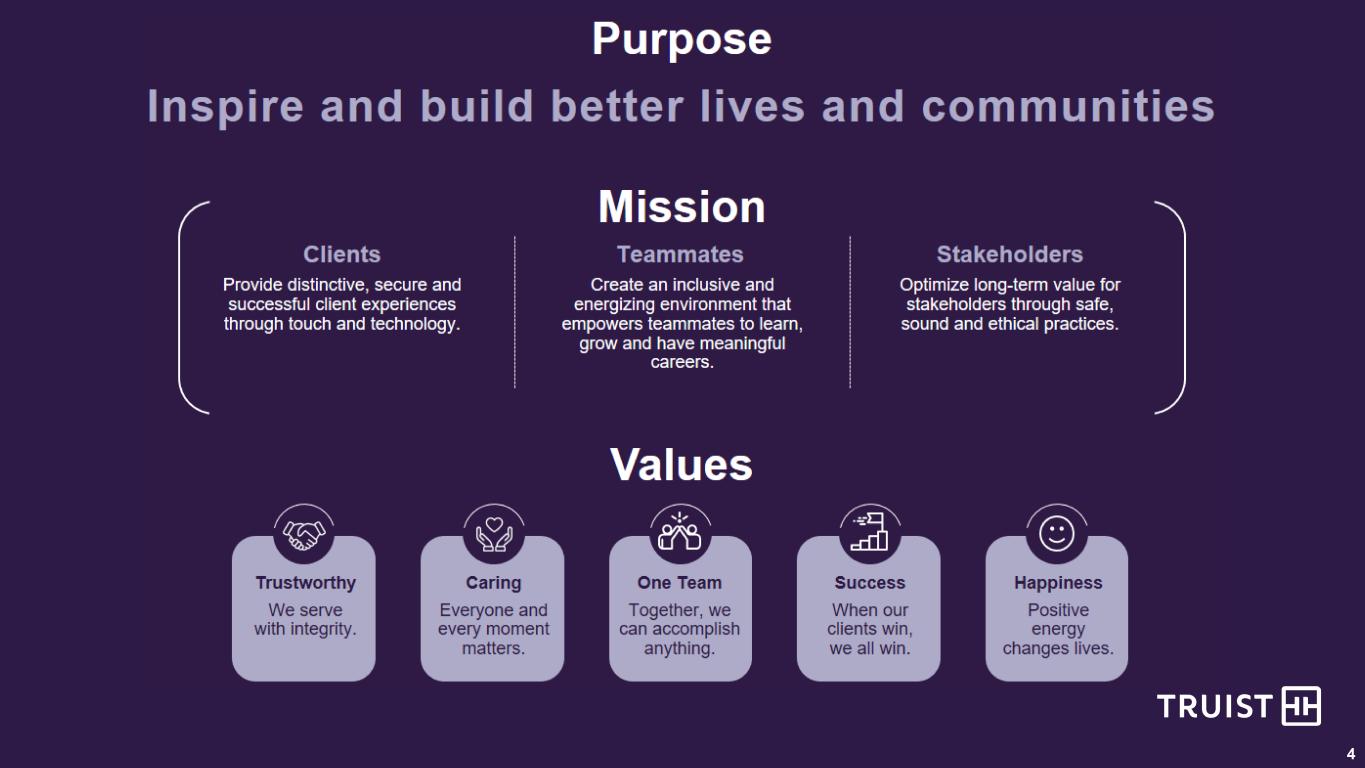
4

Financial Results
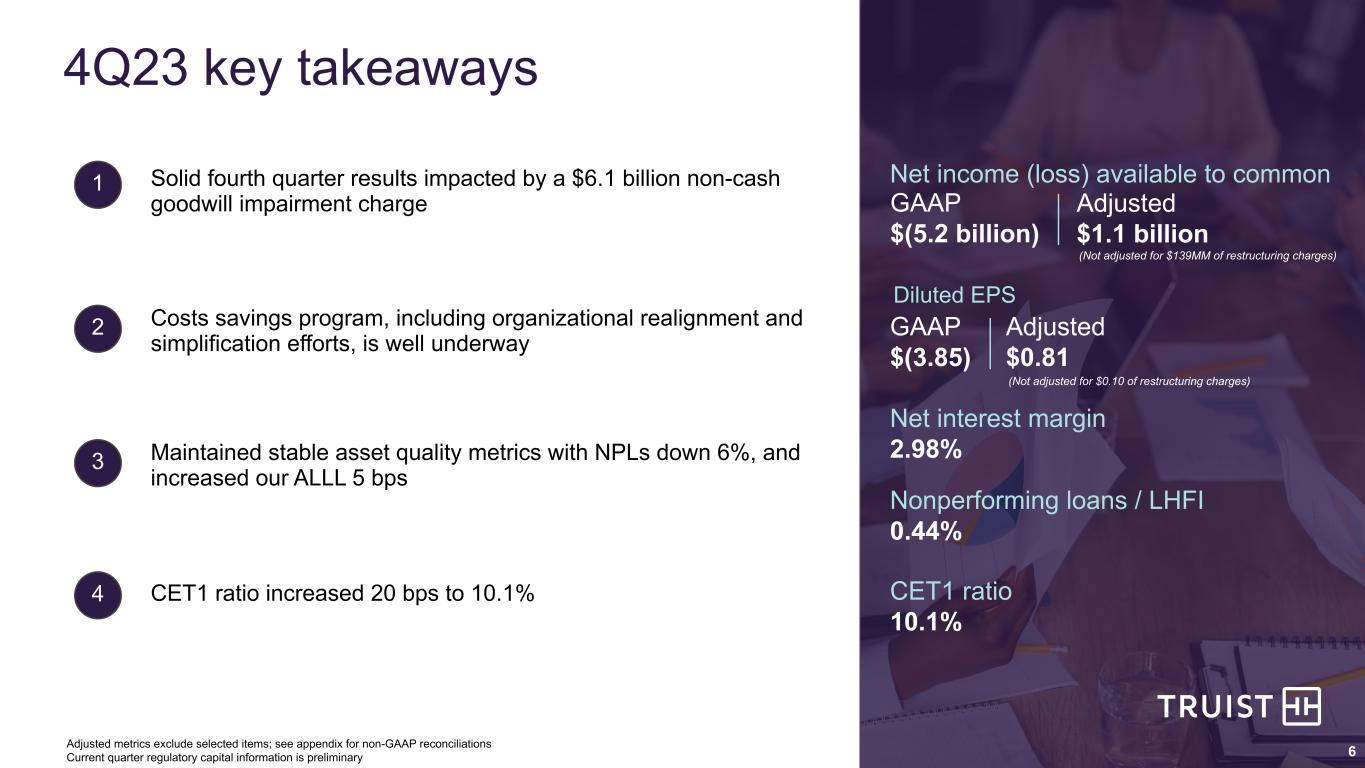
6 4Q23 key takeaways 1 Solid fourth quarter results impacted by a $6.1 billion non-cash goodwill impairment charge 2 Costs savings program, including organizational realignment and simplification efforts, is well underway 4 CET1 ratio increased 20 bps to 10.1% Net interest margin 2.98% CET1 ratio 10.1% Nonperforming loans / LHFI 0.44% 3 Maintained stable asset quality metrics with NPLs down 6%, and increased our ALLL 5 bps 6 GAAP $(5.2 billion) Adjusted $1.1 billion Diluted EPS GAAP $(3.85) Adjusted $0.81 (Not adjusted for $139MM of restructuring charges) (Not adjusted for $0.10 of restructuring charges) Net income (loss) available to common Adjusted metrics exclude selected items; see appendix for non-GAAP reconciliations Current quarter regulatory capital information is preliminary

7 19 20 23 25 27 4Q22 1Q23 2Q23 3Q23 4Q23 Empowering Clients Through T3: Truist Assist 4Q22 1Q23 2Q23 3Q23 4Q23 Building client-centered experiences 4.4 4.5 4.6 4.7 4.8 4Q22 1Q23 2Q23 3Q23 4Q23 1 Active users reflect clients that have logged in using the mobile app over the prior 90 days 2 Digital transactions include transfers, Zelle, bill payments, mobile deposits, ACH, and wire transfers 3 Client satisfaction: How satisfied are you with your most recent experience using digital banking with Truist? Mobile App Users1 Zelle Transactions Digital Transactions2 Increase in Client Satisfaction With Digital3 66 67 71 72 75 4Q22 1Q23 2Q23 3Q23 4Q23 +1% +2% +1% +9% +43% +13% +0% +7% (in millions) (in millions) (in millions) Innovative Technology + Touch – Truist Assist began its second year in market in 4Q23 with clients engaging in 26% more interactions vs. 3Q23 reflecting a surge in client adoption – In 4Q23, 85% of conversations were completed with the automated assistant, which leverages AI and natural-language processing and understanding to address over 160 unique client inquiries Building Trust – In moments that matter, live agents are available to assist with product solutions and complex transactions – In 2024, we expect Truist Assist to maintain high containment with accelerated adoption and offer clients more self-service capabilities, driving operational efficiency +3%

8 Earnings – Fourth quarter 2023 net loss of $5.2 billion, or $3.85 per share was impacted by: – $6.1 billion ($6.1 billion after tax), or $4.53 per share non-cash goodwill impairment charge which has no impact on regulatory capital ratios, liquidity, or our ability to pay our common dividend and serve our clients – $507 million ($387 million after tax), or $0.29 per share special FDIC assessment – $204 million, or $0.15 per share discrete tax benefit – $183 million ($139 million after tax), or $0.10 per share primarily due to restructuring charges related to our cost savings program Revenue and expenses – Revenue increased 0.5% vs. 3Q23 to $5.8 billion as higher noninterest income was partially offset by lower net interest income – Adjusted noninterest expenses declined 4.5% due primarily to lower personnel expense – Adjusted noninterest expense, excluding TIH independence readiness costs, decreased 5.2% Net interest margin – Net interest margin increased 3 bps to 2.98% – Cumulative total deposit beta was 36% in 4Q23 vs. 35% in 3Q23 – Cumulative interest-bearing deposit beta was 50% in 4Q23 vs. 49% in 3Q23 Capital and credit – CET1 increased 20 bps vs. 3Q23 to 10.1% – The ALLL ratio increased 5 bps, while NPLs decreased 6% – Tangible book value improved 13% to $21.83 per share 4Q23 performance highlights GAAP / Unadjusted 4Q23 3Q23 4Q22 Revenue $5,756 $5,729 $6,258 Expense $10,280 $3,747 $3,722 PPNR $(4,524) $1,982 $2,536 Provision for credit losses $572 $497 $467 Net income (loss) available to common $(5,167) $1,071 $1,610 Diluted EPS $(3.85) $0.80 $1.20 Net interest margin 2.98% 2.95% 3.25% Efficiency ratio 180.4% 66.1% 60.0% CET1 ratio 10.1% 9.9% 9.0% TBVPS $21.83 $19.25 $18.04 Change vs. Adjusted1 4Q23 3Q23 4Q22 Revenue $5,756 0.5% (8.0)% Expense $3,382 (4.5)% (0.2)% PPNR $2,374 8.6% (17.3)% Net income (loss) available to common2 $1,094 2.1% (37.1)% Diluted EPS2 $0.81 1.3% (37.7)% Efficiency ratio 58.8% (300) bps 460 bps Note: All data points are taxable-equivalent, where applicable Current quarter regulatory capital information is preliminary 1 Adjusted metrics exclude selected items; see appendix for non-GAAP reconciliations 2 These non-GAAP metrics do not adjust for merger-related and restructuring charges for 2023 periods Summary Income Statement Commentary ($ in millions, except per share data)

9 Average loans and leases HFI ($ in billions) $321 $326 $326 $318 $313 $188 $194 $195 $193 $190 $133 $132 $131 $125 $123 Commercial LHFI Consumer, mortgage, & card LHFI Loans HFI yield (%) Loans HFI yield ex. PAA (%) 4Q22 1Q23 2Q23 3Q23 4Q23 – Average loans decreased $5.5 billion, or 1.7% from 3Q23 – Average commercial loans decreased $3.5 billion, or 1.8% driven by a $3.7 billion decrease in average C&I loans partially offset by a modest increase in commercial construction loans – Average consumer loans declined $2.0 billion, or 1.8% largely due to a $1.5 billion decline in indirect auto and an approximate decline of $500 million in mortgage loans 5-Quarter Trend vs. Linked Quarter May not foot due to rounding 5.14% 5.72% 5.25% 5.81% 6.07% 5.98% 6.25% 6.18% 6.36% 6.31%

10 ($ in billions) $413 $408 $400 $401 $395 $272 $277 $276 $282 $281 $141 $131 $124 $119 $115 Interest-bearing deposits Noninterest-bearing deposits Total deposit cost (%) 4Q22 1Q23 2Q23 3Q23 4Q23 Average deposits Cumulative beta calculations are based on change in average total deposit or interest-bearing deposit cost divided by change in average Fed Funds from 4Q21 to 4Q23, respectively – Average deposits decreased $5.7 billion, or 1.4% – Average noninterest-bearing deposits declined $4.3 billion, or 3.7% – Represented 29% of total deposits vs. 30% in 3Q23 – Average money market deposits decreased $2.5 billion, or 1.8% – Deposit costs increased primarily due to continued mix shift from lower cost deposit accounts – Total cost of deposits was 190 bps, up 9 bps from the prior quarter – Cumulative total deposit beta was 36% in 4Q23 vs. 35% in 3Q23 – Total cost of interest-bearing deposits was 267 bps, up 10 bps from the prior quarter – Cumulative interest-bearing deposit beta was 50% in 4Q23 vs. 49% in 3Q23 vs. Linked Quarter 5-Quarter Trend 0.66% 1.12% 1.51% 1.81% 1.90%
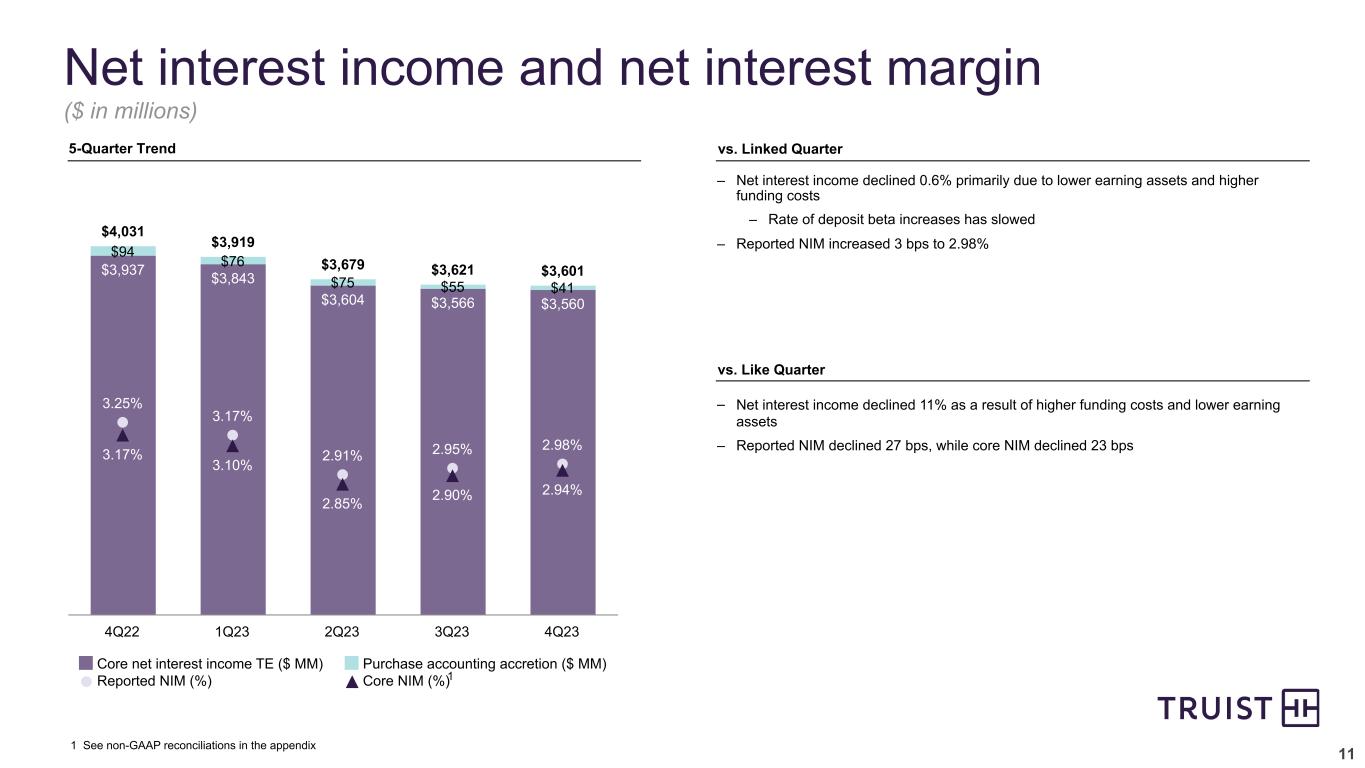
11 $4,031 $3,919 $3,679 $3,621 $3,601$3,937 $3,843 $3,604 $3,566 $3,560 $94 $76 $75 $55 $41 3.25% 3.17% 2.91% 2.95% 2.98% 3.17% 3.10% 2.85% 2.90% 2.94% Core net interest income TE ($ MM) Purchase accounting accretion ($ MM) Reported NIM (%) Core NIM (%) 4Q22 1Q23 2Q23 3Q23 4Q23 – Net interest income declined 0.6% primarily due to lower earning assets and higher funding costs – Rate of deposit beta increases has slowed – Reported NIM increased 3 bps to 2.98% – Net interest income declined 11% as a result of higher funding costs and lower earning assets – Reported NIM declined 27 bps, while core NIM declined 23 bps ($ in millions) Net interest income and net interest margin 1 See non-GAAP reconciliations in the appendix vs. Linked Quarter5-Quarter Trend 1 vs. Like Quarter

12 ($ in millions) Noninterest income vs. Linked Quarter – Noninterest income increased 2.2% as higher services charges on deposits, lending related fees, and seasonal growth in insurance income were partially offset by lower other income – Service charges on deposits increased $76 million as the prior quarter was impacted by revisions in deposit service fee protocols – Lending related fees increased due to higher leasing-related gains – Other income decreased primarily due to lower income from certain solar equity investments vs. Like Quarter – Noninterest income decreased 3.2% as lower investment banking and trading income, services charges on deposits, and mortgage banking income were partially offset by growth in insurance and increases in lending related fees 4Q23 3Q23 4Q22 Insurance income $ 813 $ 793 $ 766 Wealth management income 346 343 324 Investment banking and trading income 165 185 257 Service charges on deposits 228 152 257 Card and payment related fees 232 238 245 Mortgage banking income 94 102 117 Lending related fees 153 102 110 Operating lease income 60 63 68 Other income 64 130 83 Total noninterest income $ 2,155 $ 2,108 $ 2,227 Noninterest Income

13 – Noninterest expense increased $6.5 billion due primarily to the following: – A non-cash goodwill impairment charge of $6.1 billion – FDIC special assessment of $507 million – Merger-related and restructuring charges increased $108 million driven primarily by severance expense associated with our cost savings program – These items were offset by a $183 million decline in personnel expense – Adjusted noninterest expense decreased $160 million, or 4.5% – Decrease driven by lower personnel and other expense, partially offset by higher professional fees – Adjusted noninterest expense, excluding TIH independence readiness costs, decreased $182 million, or 5.2% ($ in millions) – Noninterest expense increased $6.6 billion driven by the goodwill impairment, FDIC special assessment, and restructuring costs – Adjusted noninterest expense decreased $7 million, or 0.2% – Decrease driven by lower personnel expense, partially offset by higher other expense and regulatory costs – Adjusted noninterest expense, excluding TIH independence readiness costs, decreased $38 million, or 1.1% Noninterest expense vs. Linked Quarter vs. Like Quarter $54 4Q23 3Q23 4Q22 Personnel expense $ 2,017 $ 2,200 $ 2,198 Professional fees and outside processing 358 317 347 Software expense 240 238 241 Net occupancy expense 172 180 179 Amortization of intangibles 130 130 163 Equipment expense 110 97 124 Marketing and customer development 62 78 70 Depreciation-property under operating leases 42 43 44 Regulatory costs 599 77 52 Merger-related and restructuring charges 183 75 114 Goodwill impairment 6,078 — — Other expense 289 312 190 Total noninterest expense $ 10,280 $ 3,747 $ 3,722 Goodwill impairment $ 6,078 $ — $ — FDIC special assessment 507 — — Incremental op. expenses related to the merger — — 56 Merger-related and restructuring charges 183 75 114 Amortization of intangibles 130 130 163 Adjusted noninterest expense $ 3,382 $ 3,542 $ 3,389 Adjusted noninterest expense excludes merger-related charges, incremental operating expenses related to the merger, amortization, and other items. See appendix for non-GAAP reconciliation. Merger costs include merger-related and restructuring charges and incremental operating expenses related to the merger Noninterest Expense

14 $467 $502 $538 $497 $572 4Q22 1Q23 2Q23 3Q23 4Q23 $273 $297 $440 $405 $453 0.34% 0.37% 0.54% 0.51% 0.57% NCO NCO ratio 4Q22 1Q23 2Q23 3Q23 4Q23 NCOs increased 6 bps linked quarter reflecting higher commercial and other consumer losses ($ in MM) Asset quality 4.5x 9.0x 8.8x Net Charge-Offs Provision for Credit Losses Nonperforming Loans / LHFI ALLL $4,377 $4,479 $4,606 $4,693 $4,798 ALLL ALLL ratio ALLL / NCO 4Q22 1Q23 2Q23 3Q23 4Q23 ALLL ratio up 5 bps due to increased reserves for an updated economic outlook ($ in MM) Asset quality metrics solid and normalizing NPLs declined 6% on a linked quarter basis 0.36% 0.36% 0.47% 0.46% 0.44% 4Q22 1Q23 2Q23 3Q23 4Q23 3.7X4.1X 2.6X Provisions increased on a linked quarter basis due to higher charge-offs and an allowance build ($ in MM) 2.9X 1.34% 1.37% 1.43% 1.49% 2.7X 1.54%

15 3Q23 CET1 Organic capital generation and managed RWA optimization Tax benefit FDIC special assessment 4Q23 CET1 ($ in billions) Continued capital momentum 1 Organic capital generation is retained earnings net of dividend 2 Current quarter regulatory capital information is preliminary 3 Based on April 2023 valuation 4 AOCI impact based on current interest rates as of 12/31/23 and internal estimates. Includes AOCI for securities and pension. Excludes cash flow hedges, which are not included in capital ratios under Basel III impacts. May not foot due to rounding. 5 Pension AOCI held constant but can change with fluctuations in financial markets ~0.25% ~(0.1%) 9.9% 10.1% Estimate if remaining TIH ownership divested3 ~2.0%+ 1 AOCI Burn Down44Q23 Capital Walk Commentary CET1 increased 20 bps to 10.1% – No impact from goodwill impairment charge – Maintain ~200 bps + of strategic flexibility with TIH Capital allocation priorities – Support organic growth needs of new and existing core clients – Payment of $0.52 per share quarterly common dividend – Expect CET1 ratio to remain above 10% Impact of lower interest rates in 4Q23 – Tangible book value improved 13% to $21.83 per share – AOCI4 improved $2.8 billion or 19% from 9/30 Manageable capital requirements under proposed Basel III rules – Expect a mid single digit % increase in RWA vs. high single digit increase previously – Expect to meet long-term debt requirements through normal course debt issuance – Phase-in period with Basel III and LTD requirements allow time to comply 2 Truist continues to build capital and maintains significant strategic flexibility with its remaining stake in TIH Securities AOCI projected to decline by 28% by 12/31/26 $1.1 $1.1 $1.1 $1.1 $11.1 $10.2 $9.1 $8.0 Securities AOCI Pension AOCI 12/31/23 12/31/24 12/31/25 12/31/26 5 $12.2 $11.2 $10.1 $9.1 ~0.05%

16 13.9% 4Q23 Actuals 1Q24 Outlook Revenue (TE) $5.8 Flat to down 1% Adjusted expenses $3.4 (includes costs related to TIH independence readiness) Up 4% (includes costs related to TIH independence readiness) Full Year 2023 Actuals Full Year 2024 Outlook Revenue (TE) $23.6 Down 1% – 3% Adjusted expenses $14.0 (includes costs related to TIH independence readiness ) Flat to up 1% (includes ~$85 million of costs related to TIH independence readiness) Net charge-off ratio 50 bps ~65 bps Tax rate 17% effective; 20% on FTE basis 1Q24 and 2024 outlook Fu ll ye ar 2 02 4 co m pa re d to fu ll ye ar 2 02 3 ($ in billions unless otherwise noted) 1Q 24 co m pa re d to 4 Q 23 All data points are taxable-equivalent, where applicable Adjusted expenses exclude amortization of intangibles, merger-related and restructuring charges, incremental operating expenses related to the merger, and other selected items Adjusted revenues exclude securities gains / (losses) and other selected items See non-GAAP reconciliations in the appendix

17 13.9% Strategic actions and priorities 2023 Actions 2024 Top Priorities – Increased client development productivity and grew net new deposit accounts – Realigned and simplified our organization to improve efficiency and the client experience – Made significant progress on $750 million gross cost savings program – Improved our capital position and built reserve levels – Grow and deepen core client relationships – Leverage our more efficient platform to grow market share – Limit expense growth to 0-1% in 2024 – Increase capital ratios, maintain sound risk controls, and preserve strong asset quality metrics – Enhance the client experience through T3 (touch + technology = trust) Recent actions and execution of 2024 top priorities will lead to improved franchise and shareholder value

Appendix

A-19 Hotel 8% Industrial 17% Office 17% Multifamily 33% Retail 14% Other 11% 7.8% 9.7% 11.1% 11.3% 11.7% 0.29% 0.41% 1.01% 1.09% 1.05% 0.14% 0.06% 0.49% 1.02% 0.70% Criticized & classified ratio NPL ratio NCO ratio 4Q22 1Q23 2Q23 3Q23 4Q23 CRE 9.4% 26% 25% 16% 33% 2024 2025 2026 2027 and beyond Commercial real estate (CRE) spotlight 5-Quarter Total CRE Trends Total LHFI at 12/31/23 ($312B) CRE Office 1.7% CRE Mix Scheduled Office Maturities CRE Represents 9.4% of Total Loans HFI, Including Office at 1.7% NPL% 6.00% LTM NCO ratio 3.18% Loan loss reserves 8.5% WALTV ~61% % in Truist Southeast/ Mid-Atlantic footprint 76% Office Spotlight All other loans 90.6% CRE information on this slide includes the commercial construction portfolio WALTV based on most recent appraisal conducted A-1 Office Portfolio Primarily Composed of Class A, Multi Tenant Properties Within Footprint Class A 64% Class B 25% Class C and Other 11% Multi Tenant 89% Medical 8% Single Tenant 3% Class Type (From Top 10 Markets) Tenant Type

A-2 Consumer Banking & Wealth Income statement ($ MM) 4Q23 vs. 3Q23 vs. 4Q22 Net interest income $2,675 $13 $(311) Allocated provision for credit losses 348 100 37 Noninterest income 855 100 10 Goodwill impairment 3,361 3,361 3,361 Noninterest expense ex. goodwill impairment 2,190 124 276 Segment net income (loss) $(2,611) $(3,448) $(3,837) Balance Sheet ($ B) Average loans(1) $135 $(2.6) $(9.3) Average deposits 233 (4.1) (12) Other Key Metrics(2) Mortgages serviced for others ($ B) $213 $(1.6) $(3.6) Wealth management AUM ($ B) 199 11 19 Branches 2,001 — (122) (1) Excludes loans held for sale (2) Amount reported reflects end of period balance Represents performance for Retail and Small Business Banking, Wealth, Mortgage Banking, and Consumer Finance Solutions – Net loss of $2.6 billion, compared to net income of $837 million in the prior quarter – Includes $3.4 billion goodwill impairment – Net interest income of $2.7 billion increased slightly by $13 million, or 0.5% primarily driven by higher funding credit on deposits and interest rates, partially offset by lower average deposit and loan balances – Average loans of $135 billion declined 1.9% vs. 3Q23 primarily driven by lower prime auto and mortgage, partially offset by growth in Service Finance – Average deposits of $233 billion declined 1.7% vs. 3Q23, reflecting continued consumer response to higher rates – Provision for credit losses increased $100 million, or 40.3% vs. 3Q23, reflecting an increase in net charge-offs and ACL build in the current quarter – Noninterest income of $855 million increased $100 million, or 13% vs. 3Q23, primarily driven by prior quarter revisions in deposit service fee protocols – Mortgages serviced for others decreased 0.7% vs. 3Q23, primarily driven by higher BAU runoff – Wealth management AUM increased $11 billion, or 6.0% vs. 3Q23 primarily due to impacts of positive markets – Noninterest expense, excluding goodwill impairment, of $2.2 billion is up 6.0% vs. 3Q23, primarily driven by the FDIC special assessment – Excluding the FDIC special assessment expense, noninterest expense was $2.0 billion, down $21 million vs. 3Q23 – Branch count down 5.7% vs. 4Q22 due to continued branch network optimization Metrics Commentary
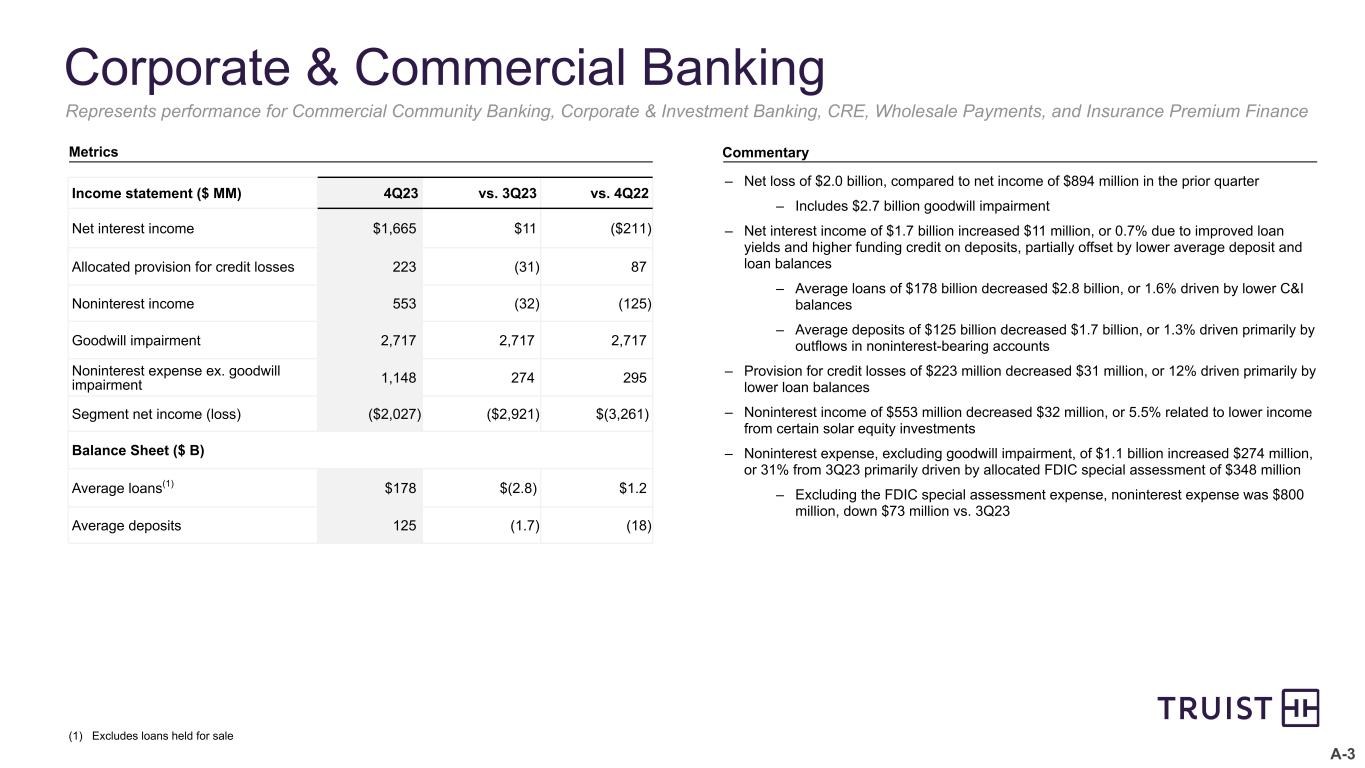
A-3 Corporate & Commercial Banking – Net loss of $2.0 billion, compared to net income of $894 million in the prior quarter – Includes $2.7 billion goodwill impairment – Net interest income of $1.7 billion increased $11 million, or 0.7% due to improved loan yields and higher funding credit on deposits, partially offset by lower average deposit and loan balances – Average loans of $178 billion decreased $2.8 billion, or 1.6% driven by lower C&I balances – Average deposits of $125 billion decreased $1.7 billion, or 1.3% driven primarily by outflows in noninterest-bearing accounts – Provision for credit losses of $223 million decreased $31 million, or 12% driven primarily by lower loan balances – Noninterest income of $553 million decreased $32 million, or 5.5% related to lower income from certain solar equity investments – Noninterest expense, excluding goodwill impairment, of $1.1 billion increased $274 million, or 31% from 3Q23 primarily driven by allocated FDIC special assessment of $348 million – Excluding the FDIC special assessment expense, noninterest expense was $800 million, down $73 million vs. 3Q23 (1) Excludes loans held for sale Represents performance for Commercial Community Banking, Corporate & Investment Banking, CRE, Wholesale Payments, and Insurance Premium Finance Metrics Commentary Income statement ($ MM) 4Q23 vs. 3Q23 vs. 4Q22 Net interest income $1,665 $11 ($211) Allocated provision for credit losses 223 (31) 87 Noninterest income 553 (32) (125) Goodwill impairment 2,717 2,717 2,717 Noninterest expense ex. goodwill impairment 1,148 274 295 Segment net income (loss) ($2,027) ($2,921) $(3,261) Balance Sheet ($ B) Average loans(1) $178 $(2.8) $1.2 Average deposits 125 (1.7) (18)

A-4 Insurance Holdings – Revenue increased 7.4% vs. 4Q22 – Organic revenue growth was 7.3% vs. 4Q22 – New business generation was strong with improving retention – Noninterest expense increased 12% vs. 4Q22 – Increase driven by insurance readiness expense and increased personnel cost due to revenue growth and net new producer hires Market Conditions – P&C premium rate increases remained relatively consistent vs. prior quarters – Continue to see growth in exposure units and growth in the value of the exposure units due to inflation (1) Prior period noninterest expense includes the segment net interest income which was primarily an allocation (2) EBITDA is a non-GAAP measurement of operating profitability that is calculated by adding back interest, taxes, depreciation, and amortization to net income. Truist’s management also adds back merger-related and restructuring charges, acquisition retention and changes in estimated earn-out incentives, equity and equity-like compensation items, independence readiness costs related to Truist Insurance Holdings, and other selected items. Truist’s management uses this measure in its analysis of the Corporation’s Insurance Holdings segment. Truist’s management believes this measure provides a greater understanding of ongoing operations and enhances comparability of results with prior periods, as well as demonstrates the effects of significant gains and charges. See non-GAAP reconciliations included in the attached Appendix. Represents performance for Truist Insurance Holdings’ Retail and Wholesale Divisions Metrics Commentary Income statement ($ MM) 4Q23 vs. 3Q23 vs. 4Q22 Noninterest income $830 $29 $38 Interest income 21 (4) 21 Total revenue 851 25 59 Noninterest expense(1) 743 42 81 Interest expense 105 — 105 Segment net income $1 (16) (106) Performance ($ MM) YoY organic revenue growth 7.3 % 1.0 % 1.7 % Net acquired revenue $1 ($25) ($61) Performance based commissions 25 6 (6) Adjusted EBITDA(2) 219 10 (7) Adjusted EBITDA margin(2) 25.7 % 0.4 % (2.9) %
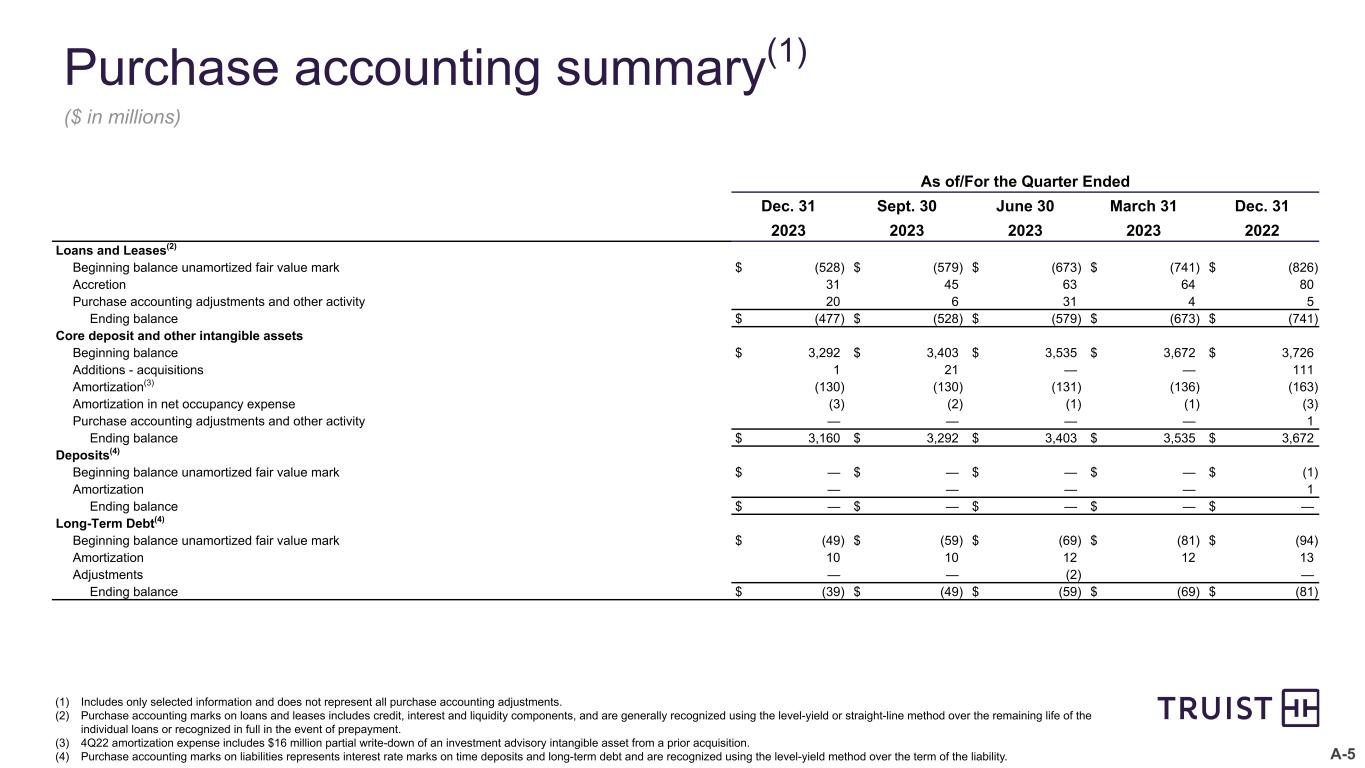
A-5 Purchase accounting summary(1) ($ in millions) As of/For the Quarter Ended Dec. 31 Sept. 30 June 30 March 31 Dec. 31 2023 2023 2023 2023 2022 Loans and Leases(2) Beginning balance unamortized fair value mark $ (528) $ (579) $ (673) $ (741) $ (826) Accretion 31 45 63 64 80 Purchase accounting adjustments and other activity 20 6 31 4 5 Ending balance $ (477) $ (528) $ (579) $ (673) $ (741) Core deposit and other intangible assets Beginning balance $ 3,292 $ 3,403 $ 3,535 $ 3,672 $ 3,726 Additions - acquisitions 1 21 — — 111 Amortization(3) (130) (130) (131) (136) (163) Amortization in net occupancy expense (3) (2) (1) (1) (3) Purchase accounting adjustments and other activity — — — — 1 Ending balance $ 3,160 $ 3,292 $ 3,403 $ 3,535 $ 3,672 Deposits(4) Beginning balance unamortized fair value mark $ — $ — $ — $ — $ (1) Amortization — — — — 1 Ending balance $ — $ — $ — $ — $ — Long-Term Debt(4) Beginning balance unamortized fair value mark $ (49) $ (59) $ (69) $ (81) $ (94) Amortization 10 10 12 12 13 Adjustments — — (2) — Ending balance $ (39) $ (49) $ (59) $ (69) $ (81) (1) Includes only selected information and does not represent all purchase accounting adjustments. (2) Purchase accounting marks on loans and leases includes credit, interest and liquidity components, and are generally recognized using the level-yield or straight-line method over the remaining life of the individual loans or recognized in full in the event of prepayment. (3) 4Q22 amortization expense includes $16 million partial write-down of an investment advisory intangible asset from a prior acquisition. (4) Purchase accounting marks on liabilities represents interest rate marks on time deposits and long-term debt and are recognized using the level-yield method over the term of the liability.

A-6 Preferred dividend ($ in millions) 1Q24 2Q24 3Q24 4Q24 Estimated dividends based on projected interest rates and amounts outstanding ($ MM) $106 $77 $105 $75 Estimates assume forward-looking SOFR rates as of 12/31/23. Actual interest rates could vary significantly causing dividend payments to differ from the estimates shown above.

Non-GAAP Reconciliations

A-8 Quarter Ended Year Ended Dec. 31 Sept. 30 June 30 March 31 Dec. 31 Dec. 31 Dec. 31 2023 2023 2023 2023 2022 2023 2022 Net income (loss) available to common shareholders - GAAP $ (5,167) $ 1,071 $ 1,234 $ 1,410 $ 1,610 $ (1,452) $ 5,927 Merger-related and restructuring charges — — — — 87 — 393 Securities (gains) losses — — — — — — 54 Loss (gain) on early extinguishment of debt — — — — — — (30) Incremental operating expenses related to the merger — — — — 43 — 356 Goodwill impairment 6,078 — — — — 6,078 — FDIC special assessment 387 — — — — 387 — Gain on redemption of noncontrolling equity interest — — — — — — (57) Discrete tax benefit (204) — — — — (204) — Adjusted net income available to common shareholders(1) $ 1,094 $ 1,071 $ 1,234 $ 1,410 $ 1,740 $ 4,809 $ 6,643 Weighted average shares outstanding - diluted 1,342,790 1,340,574 1,337,307 1,339,480 1,337,338 1,339,895 1,338,462 Diluted EPS - GAAP $ (3.85) $ 0.80 $ 0.92 $ 1.05 $ 1.20 $ (1.08) $ 4.43 Diluted EPS - adjusted(1) 0.81 0.80 0.92 1.05 1.30 3.59 4.96 Non-GAAP reconciliations Adjusted Net Income and Diluted EPS ($ in millions, except per share data, shares in thousands) (1) Adjusted net income available to common shareholders and diluted earnings per share are non-GAAP in that these measures exclude selected items, net of tax. Truist’s management uses these measures in their analysis of the Corporation’s performance. Truist’s management believes these measures provide a greater understanding of ongoing operations and enhances comparability of results with prior periods, as well as demonstrate the effects of significant gains and charges.
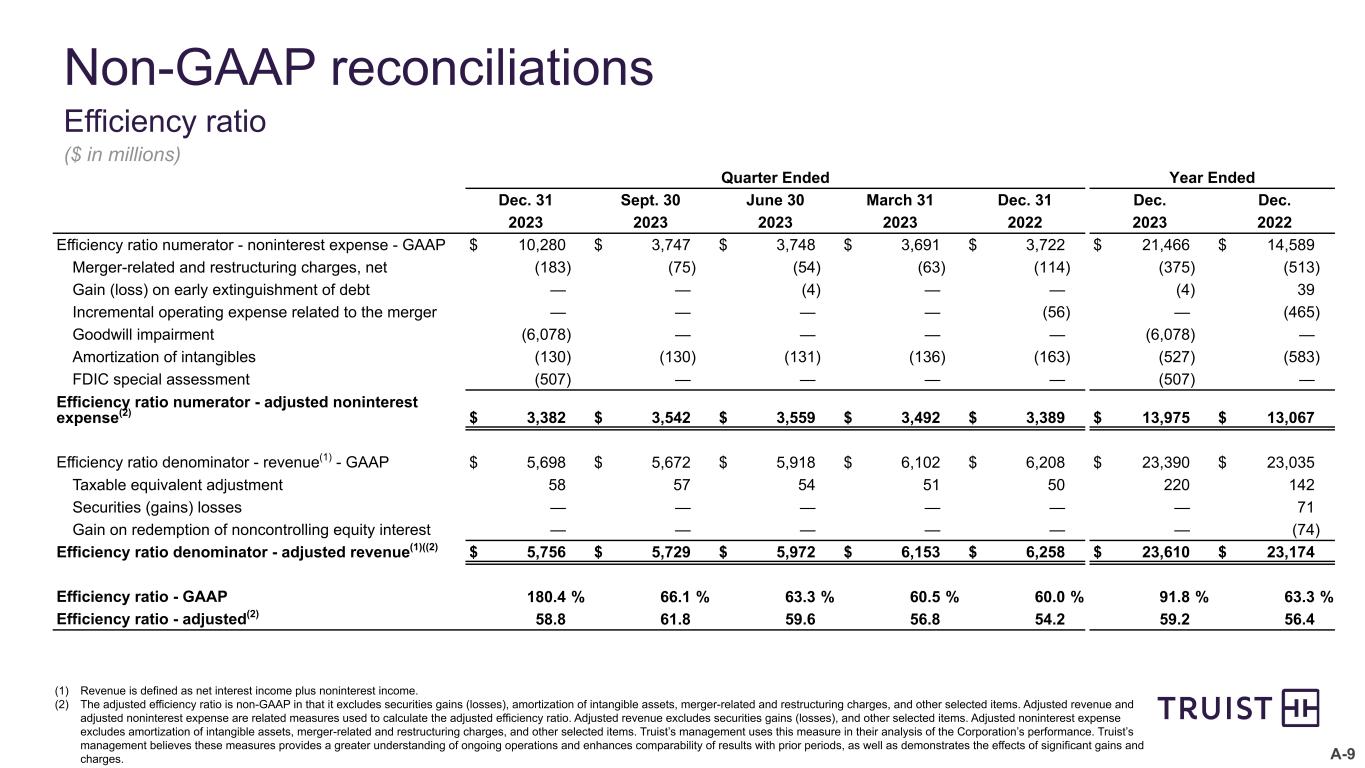
A-9 Non-GAAP reconciliations Efficiency ratio ($ in millions) (1) Revenue is defined as net interest income plus noninterest income. (2) The adjusted efficiency ratio is non-GAAP in that it excludes securities gains (losses), amortization of intangible assets, merger-related and restructuring charges, and other selected items. Adjusted revenue and adjusted noninterest expense are related measures used to calculate the adjusted efficiency ratio. Adjusted revenue excludes securities gains (losses), and other selected items. Adjusted noninterest expense excludes amortization of intangible assets, merger-related and restructuring charges, and other selected items. Truist’s management uses this measure in their analysis of the Corporation’s performance. Truist’s management believes these measures provides a greater understanding of ongoing operations and enhances comparability of results with prior periods, as well as demonstrates the effects of significant gains and charges. Quarter Ended Year Ended Dec. 31 Sept. 30 June 30 March 31 Dec. 31 Dec. Dec. 2023 2023 2023 2023 2022 2023 2022 Efficiency ratio numerator - noninterest expense - GAAP $ 10,280 $ 3,747 $ 3,748 $ 3,691 $ 3,722 $ 21,466 $ 14,589 Merger-related and restructuring charges, net (183) (75) (54) (63) (114) (375) (513) Gain (loss) on early extinguishment of debt — — (4) — — (4) 39 Incremental operating expense related to the merger — — — — (56) — (465) Goodwill impairment (6,078) — — — — (6,078) — Amortization of intangibles (130) (130) (131) (136) (163) (527) (583) FDIC special assessment (507) — — — — (507) — Efficiency ratio numerator - adjusted noninterest expense(2) $ 3,382 $ 3,542 $ 3,559 $ 3,492 $ 3,389 $ 13,975 $ 13,067 Efficiency ratio denominator - revenue(1) - GAAP $ 5,698 $ 5,672 $ 5,918 $ 6,102 $ 6,208 $ 23,390 $ 23,035 Taxable equivalent adjustment 58 57 54 51 50 220 142 Securities (gains) losses — — — — — — 71 Gain on redemption of noncontrolling equity interest — — — — — — (74) Efficiency ratio denominator - adjusted revenue(1)((2) $ 5,756 $ 5,729 $ 5,972 $ 6,153 $ 6,258 $ 23,610 $ 23,174 Efficiency ratio - GAAP 180.4 % 66.1 % 63.3 % 60.5 % 60.0 % 91.8 % 63.3 % Efficiency ratio - adjusted(2) 58.8 61.8 59.6 56.8 54.2 59.2 56.4

A-10 Non-GAAP reconciliations Pre-provision net revenue ($ in millions) (1) Pre-provision net revenue is a non-GAAP measure that adjusts net income determined in accordance with GAAP to exclude the impact of the provision for credit losses and provision for income taxes. Adjusted pre-provision net revenue is a non-GAAP measure that additionally excludes securities gains (losses), merger-related and restructuring charges, amortization of intangible assets, and other selected items. Truist’s management believes these measures provide a greater understanding of ongoing operations and enhances comparability of results with prior periods. Quarter Ended Year Ended Dec. 31 Sept. 30 June 30 March 31 Dec. 31 Dec. 31 Dec. 31 2023 2023 2023 2023 2022 2023 2022 Net income $ (5,090) $ 1,183 $ 1,345 $ 1,515 $ 1,682 $ (1,047) $ 6,267 Provision for credit losses 572 497 538 502 467 2,109 777 Provision for income taxes (64) 245 287 394 337 862 1,402 Taxable-equivalent adjustment 58 57 54 51 50 220 142 Pre-provision net revenue(1) $ (4,524) $ 1,982 $ 2,224 $ 2,462 $ 2,536 $ 2,144 $ 8,588 Merger-related and restructuring charges, net 183 75 54 63 114 375 513 Gain (loss) on early extinguishment of debt — — 4 — — 4 (39) Incremental operating expense related to the merger — — — — 56 — 465 Goodwill impairment 6,078 — — — — 6,078 — Amortization of intangibles 130 130 131 136 163 527 583 FDIC special assessment 507 — — — — 507 — Securities (gains) losses — — — — — — 71 Gain on redemption of noncontrolling equity interest — — — — — — (74) Pre-provision net revenue - adjusted(1) $ 2,374 $ 2,187 $ 2,413 $ 2,661 $ 2,869 $ 9,635 $ 10,107

A-11 Non-GAAP reconciliations Calculations of tangible common equity and related measures ($ in millions, except per share data, shares in thousands) (1) Tangible common equity and related measures are non-GAAP measures that exclude the impact of intangible assets, net of deferred taxes, and their related amortization and impairment charges. These measures are useful for evaluating the performance of a business consistently, whether acquired or developed internally. Truist’s management uses these measures to assess profitability, returns relative to balance sheet risk, and shareholder value. These measures are not necessarily comparable to similar measures that may be presented by other companies. As of / Quarter Ended Year Ended Dec. 31 Sept. 30 June 30 March 31 Dec. 31 Dec. 31 Dec. 31 2023 2023 2023 2023 2022 2023 2022 Common shareholders’ equity $ 52,428 $ 55,167 $ 56,853 $ 55,699 $ 53,841 Less: Intangible assets, net of deferred taxes 23,306 29,491 29,628 29,788 29,908 Tangible common shareholders’ equity(1) $ 29,122 $ 25,676 $ 27,225 $ 25,911 $ 23,933 Outstanding shares at end of period 1,333,743 1,333,668 1,331,976 1,331,918 1,326,829 Common shareholders’ equity per common share $ 39.31 $ 41.37 $ 42.68 $ 41.82 $ 40.58 Tangible common shareholders’ equity per common share(1) 21.83 19.25 20.44 19.45 18.04 Net income available to common shareholders $ (5,167) $ 1,071 $ 1,234 $ 1,410 $ 1,610 $ (1,452) $ 5,927 Plus: goodwill impairment 6,078 — — — — 6,078 — Plus: amortization of intangibles, net of tax 99 99 100 104 125 402 446 Tangible net income available to common shareholders(1) $ 1,010 $ 1,170 $ 1,334 $ 1,514 $ 1,735 $ 5,028 $ 6,373 Average common shareholders’ equity $ 56,061 $ 56,472 $ 57,302 $ 55,380 $ 54,823 $ 56,306 $ 57,124 Less: Average intangible assets, net of deferred taxes 29,377 29,570 29,775 29,889 29,891 29,651 29,253 Average tangible common shareholders’ equity(1) $ 26,684 $ 26,902 $ 27,527 $ 25,491 $ 24,932 $ 26,655 $ 27,871 Return on average common shareholders’ equity (36.6) % 7.5 % 8.6 % 10.3 % 11.7 % (2.6) % 10.4 % Return on average tangible common shareholders’ equity(1) 15.0 17.3 19.4 24.1 27.6 18.9 22.9

A-12 Quarter Ended Dec. 31 Sept. 30 June 30 March 31 Dec. 31 2023 2023 2023 2023 2022 Net interest income - GAAP $ 3,543 $ 3,564 $ 3,625 $ 3,868 $ 3,981 Taxable-equivalent adjustment 58 57 54 51 50 Net interest income - taxable-equivalent 3,601 3,621 3,679 3,919 4,031 Accretion of mark on acquired loans (31) (45) (63) (64) (80) Accretion of mark on acquired liabilities (10) (10) (12) (12) (14) Net interest income - core(1) $ 3,560 $ 3,566 $ 3,604 $ 3,843 $ 3,937 Average earning assets - GAAP $ 481,345 $ 488,794 $ 506,084 $ 499,149 $ 492,805 Average balance - mark on acquired loans 496 553 641 702 787 Average earning assets - core(1) $ 481,841 $ 489,347 $ 506,725 $ 499,851 $ 493,592 Annualized net interest margin: Reported - taxable-equivalent 2.98 % 2.95 % 2.91 % 3.17 % 3.25 % Core(1) 2.94 2.90 2.85 3.10 3.17 Non-GAAP reconciliations Core NIM ($ in millions) (1) Core net interest margin is a non-GAAP measure that adjusts net interest margin to exclude the impact of purchase accounting. The purchase accounting marks and related amortization for loans, deposits, and long-term debt from mergers and acquisitions are excluded to approximate the yields paid by clients. Truist’s management believes the adjustments to the calculation of net interest margin for certain assets and liabilities acquired provide investors with useful information related to the performance of Truist’s earning assets. This measure is not necessarily comparable to similar measures that may be presented by other companies.

A-13 Non-GAAP reconciliations Insurance Holdings adjusted EBITDA ($ in millions) (1) EBITDA is a non-GAAP measurement of operating profitability that is calculated by adding back interest, taxes, depreciation, and amortization to net income. Truist’s management also adds back merger- related and restructuring charges, acquisition retention and changes in estimated earn-out incentives, equity and equity-like compensation items, independence readiness costs related to Truist Insurance Holdings, and other selected items. Truist’s management uses this measure in its analysis of the Corporation’s Insurance Holdings segment. Truist’s management believes this measure provides a greater understanding of ongoing operations and enhances comparability of results with prior periods, as well as demonstrates the effects of significant gains and charges. Quarter Ended Dec. 31 Sept. 30 June 30 March 31 Dec. 31 2023 2023 2023 2023 2022 Segment interest income $ 21 $ 25 $ 19 $ — $ — Noninterest income 830 801 944 817 792 Total revenue 851 826 963 817 792 Segment net income (loss) - GAAP $ 1 $ 17 $ 155 $ 109 $ 107 Provision (benefit) for income taxes 1 3 — 36 35 Interest 105 105 103 — — Depreciation & amortization 36 35 35 37 36 EBITDA 143 160 293 182 178 Merger-related and restructuring charges, net 21 11 3 5 18 Acquisition retention and change in earn-out incentives 5 9 4 13 8 Equity and equity-like compensation items 25 21 19 20 20 Operating loss — — — 15 — Independence readiness costs related to TIH (excluding Bank incurred costs) 25 8 3 — 2 Adjusted EBITDA(1) $ 219 $ 209 $ 322 $ 235 $ 226 Adjusted EBITDA(1) margin 25.7 % 25.3 % 33.5 % 28.7 % 28.6 % Memo: Total independence readiness costs related to TIH (including Bank incurred costs) $ 33 $ 11 $ 9 $ 1 2

To inspire and build better lives and communities